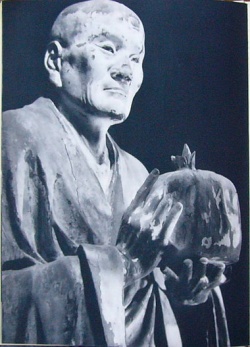Asaṅga, Vasubandhu & Shambhala
"Legend reports that Vasubandhu came from the "Kingdom of Shambhala' (approximately, modern Begram, otherwise known as the ancient kingdom of Kapisha, north of Kabul) located in the Afghanistan region, north-west of Peshawar....Bagram (بگرام Bagrám), founded as Alexandria on the Caucasus and known in medieval times as Kapisa, is a small town and seat in Bagram District in Parwan Province of Afghanistan, about 60 kilometers north of the capital Kabul..".... Website of His Holiness the 17th Gyalwa Karmapa, Urgyen Trinley Dorje......
Yogacara stands on the innovative frontier as one product of the cultural interchange that blossomed in the first and second century Gandhava region. During its long and worthy history as a major school of Buddhist thought, two great masters of its doctrines especially stand forth, namely Vasubandhu (circa 290-370 AD)1 and Manjusrimitra (circa 700 AD)....
Vasubandhu (Sanskrit: वसुबन्दु; traditional Chinese: 世親; pinyin: Shìqīn; Tibetan: དབྱིག་གཉེན་, Wylie: dbyig gnyen) (fl. 4th c.) was an Indian Buddhist monk, and along with his half-brother Asanga, one of the main founders of the Indian Yogācāra school. .....He was contemporaneous with King Chandragupta I, the father of Samudragupta. This information temporally places this Vasubandhu in the fourth century CE.....
"Vasubandhu was trained in the orthodox Sarvastivada Order of Buddhism, which had its seat at Kausambhi (near modern Allahabad, in the centre of India) during the 2nd, 3rd and 4th centuries AD. He was introduced to an early version of Yogacara theory by his elder brother Asanga, who in turn had been the disciple of a sage named Maitreyanatha. Next to nothing about the latter is known, other than that legend reports he came from the "Kingdom of Shambhala' (approximately, modern Begram, otherwise known as the ancient kingdom of Kapisha, north of Kabul) located in the Afghanistan region, north-west of Peshawar....Bagram (بگرام Bagrám), founded as Alexandria on the Caucasus and known in medieval times as Kapisa, is a small town and seat in Bagram District in Parwan Province of Afghanistan, about 60 kilometers north of the capital Kabul.."....http://www.dharmafellowship.org/library/essays/yogacara-part1.htm
Asaṅga (Sanskrit: असङ्ग; Tibetan: ཐོགས་མེད།; Wylie: Thogs med; traditional Chinese: 無著; pinyin: Wúzhuó; Romaji: Mujaku) was a major exponent of the Yogācāra tradition in India, also called Vijñānavāda. Traditionally, he and his half-brother Vasubandhu are regarded as the founders of this school. The two half-brothers were also major exponents of Abhidharma teachings, which were highly technical and sophisticated hermeneutics (broadly, is the art of text interpretation.) as well...Asaṅga was born as the son of a Kṣatriya father and Brahmin mother in Puruṣapura (present day Peshawar in Pakistan), which at that time was part of the ancient kingdom of Gandhāra. Current scholarship places him in the fourth century CE. ...In the record of his journeys through the kingdoms of India, Xuanzang wrote that Asaṅga was initially a Mahīśāsaka monk, but soon turned toward the Mahāyāna teachings. Asaṅga had a half-brother, Vasubandhu, who was a monk from the Sarvāstivāda school. Vasubandhu is said to have taken up Mahāyāna Buddhism after meeting with Asaṅga and one of Asaṅga's disciples.[6]
This informal research is an exploration of the region of ancient 'Shamis en Balkh' (36° N 66° E) as the source of the 'legendary' Kingdom of Shambhala....also known as Shams-i-Bala, it was located in the once rich and fertile region of Bactria and encircled by the great Pamir and Caucasus Asia Mountains..... Shams is also the Arabic word for "sun" (شمس). The word has roots that go back to at least the time of the writing of the Epic of Gilgamesh, which references the Akkadian deity called Shamash......This research includes the ancient cultures of Tagzig, Oddiyana, Bactra, Kapisa, Olmo Lungring, Zariasta, Zhang-Zhung, Gandharva and Uighur. Viewed as a Sacral/Human power spot ("sham-i-bala = elevated candle" ), legendary Balkh was the site of a great pre-history Sun Temple.... reached it height about 2400 BC but was still a great city when Marco Polo visited in 1275 AD.
